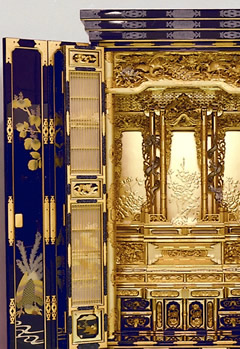IIYAMA Butsudan (Household Buddhist Altars)

The production of Buddhist household altars was established in the religious community of Iiyama at the beginning of the 17th century. The work was performed by different craftsmen in the area before being assembled at specialty stores, which served as both finishers and wholesalers of the altars. The production of these altars has been sustained by the strong faith of Iiyama’s Buddhist community, the ease with which raw materials can be obtained, and the climate, which is suitable for woodworking.
Iiyama household altars are heavy due to their generous use of wood. Extremely high-quality lacquer is applied using techniques that produce rich colors and give these altars a powerful beauty. Restoring altars that have become discolored or worn with age is a simple task because each part can be disassembled. Today, altars are produced in several styles to meet the requirements of different Buddhist sects.
Feature
Iiyama household altars have been produced since the latter half of the 17th century, using wood from pine, cedar and magnolia trees. Most of the altars produced are for the Shin school of Buddhism. Many traditional techniques are used, including honkumi-kiji, yumi-nageshi, hijiki-kumimono, tsuyadashi-oshi and more.
How to make
The production process is handled by eight departments and involves preparing the wood for the exterior, making the roof for the kuden inner sanctuary, carving the flowers, birds and other ornaments, fashioning the metal fittings, applying the maki-e gold- and silver-sprinkled lacquer decorations and gold leafing, painting and lacquering the exterior and performing the final assembly.

